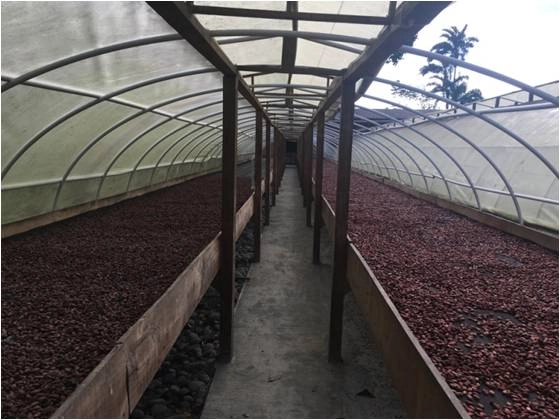
cacao gourmet
tumaco fino
Evaluation 4.5
SWEET FRUITY 3.5
CITRUS FRUITY 3.0
FLORAL 1.5
CREOLE 2.2
COCOA 4.0
WOODSY 1.5
SPICES 0.0
ANNUAL PRODUCTION (TM) 75
MAIN HARVEST DEC-MAR
MID HARVEST JUN-JUL
CREOLE BEANS 12%
FERMENTED BEANS 78%
VIOLET BEANS 10%
SLATE BEANS 12%
TOTAL 100%
Beans / 100g: 79
g./1 Bean: 1.27 g
CERTIFIED NO
AWARDS NO
Physical and Organoleptic Characteristics
Positive Flavors
Orange
Nuts
Cocoa
Wood

Assessment

S = Flavor:
MEDIUM Notes of nuts and fruity flavors
A = Aroma:
MEDIUM Essences of citrus flowers
F = Fermentation:
HIGH Low astringency and bitterness


Cut Test Analysis
Due to moderate creole genetics with 12% white beans and high trinitario descent, cut test results show: (±78%) fermented beans, (±10%) violet beans, and (±12%) slate beans.
Regarding weight, it contains 79 almonds per 100g weight, meaning each almond weighs 1.27g.

Flavor Map
Responds to the humidity conditions of Tumaco, where moderate brackish waters from the local gulf shape this cocoa profile.
Permanent atmospheric demand conditions are met, with no known water stress periods, maintaining moderate acidity of sweet fruits.
Features a humid tropical climate with varied relief from coastal foothill mountains to Pacific plains containing geographical features like bays, islands, mangroves, rivers, and lagoons.

Sensory Map
Predominates a solid cocoa base with proportional notes of acidic ripe fruits and nuts. Wood flavors reveal detectable floral and forest fragrances.

Post-Harvest Processing
Fermentation Protocol
Cocoa Type

Trinitario &

Criollo
Fermentation Days
5 to 6 days
-
Box type: Wooden
-
Turning frequency: every 24 hours
-
Fermentation method: Wooden boxes covered with plantain leaves.
Fresh cocoa pods are collected from farms during the day, transported to processing centers in plastic buckets, and placed in wooden boxes by late afternoon. Masses are covered with plantain leaves to activate acetic acid decomposition through natural yeasts.
Central fermentation process lasts 5-6 days with daily turnings.



Drying Protocol
Cocoa Type

Trinitario &

Criollo
Drying Days
5 to 8 days
Drying Techniques
-
Floor type: concrete
-
Humidity: 7.5% to 8%
-
Drying method: Sun-dried on beds under marquees
Drying begins at 6 AM by spreading beans 3-4 cm thick on marquee beds. Drying time (5-8 days) depends on climate until reaching 7.5-8% humidity. Beans are stirred hourly during initial days to separate them.


Traceability
certifications and awards
We established logistics to support farmers by reducing fermentation/drying/transport costs while guaranteeing product value at harvest. We collect fresh cocoa from high-yield farms on harvest day, then apply our "flor de baba" protocol to ensure premium quality.
Approximately 12 farmers participate in special cocoa production.
Tumaco (Nariño) is primarily inhabited by Afro-Colombians and indigenous people (population 203,971: 60% urban, 40% rural). Residents face challenges from Colombia's historical public order issues and poor governance, resulting in low-middle class living standards.
Economy based on agriculture (agroindustry), fishing, forestry, and tourism. Main products: African palm, cocoa, coconut. Contains significant hotel infrastructure.
19,400 hectares of cocoa plantations produce ~2,800 TM annually.
50% plantations use old regional hybrids (pajarito, hartón). Crop renewal programs replaced illicit crops with clonal materials: ICS 1, ICS 60, ICS 95, TSH 565, IMC 67, MON 1, and CCN 51.


Geographical Location and Ecology
Geographical Location
- Country: Colombia
- State: Nariño
- Municipality: Tumaco
- Area: 19,400 km2
- Average Altitude: 2m
- GPS Coordinates: 1°48′24″N 78°45′53″W
- Population: 203,971
Tumaco, known as the Pearl of the Pacific, is located in southwestern Colombia on the Pacific coast of Nariño near Ecuador.
Ecology
Features humid tropical climate with varied relief from Andean foothills to Pacific plains containing geographical landmarks like Tumaco Bay, Ancón de Sardinas, Cabo Manglares, and El Morro Island. Hydrological network includes Mira and Patía rivers.
Temperatures range 23-29°C (average 26°C). As one of Earth's rainiest regions, annual precipitation reaches 2,800mm with relative humidity up to 98%.
History


This Pacific pearl was discovered by Spanish conquistadors, originally home to the Tumaco-La Tolita culture whose indelible legacy remains part of municipal wealth.
Multiple accounts exist about Tumaco's founding. One suggests Spanish establishment over indigenous settlements in 1610 by missionary Onofre Esteban. Anthropologist Father José María Garrido officialized November 30, 1640 as foundation date.
Pope John Paul II visited Tumaco in 1986.
Recent years see social/political efforts to improve living standards and reduce regional violence affecting development.

